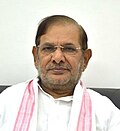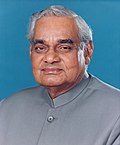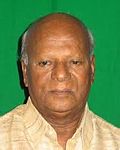| Portrait | Minister
(Birth-Death)
Constituency | Term of office | Political party | Ministry | Prime Minister |
|---|
| From | To | Period |
|---|
|  | Chandrashekhar Singh
(1927–1986)
MP for Banka
(Minister of State, I/C) | 30 March 1985 | 25 September 1985 | 179 days | Indian National Congress | Rajiv II | | Rajiv Gandhi |
|  | Khurshed Alam Khan
(1919–2013)
MP for Farrukhabad
(Minister of State, I/C) | 15 November 1985 | 22 October 1986 | 341 days |
|  | Ram Niwas Mirdha
(1924–2010)
MP for Barmer
(Minister of State, I/C until 15 Feb 1988) | 22 October 1986 | 2 December 1989 | 3 years, 41 days |
|  | Sharad Yadav
(1947–2023)
MP for Badaun | 6 December 1989 | 10 November 1990 | 339 days | Janata Dal | Vishwanath | | Vishwanath Pratap Singh |
|  | Hukmdev Narayan Yadav
(born 1939)
MP for Sitamarhi | 21 November 1990 | 21 June 1991 | 212 days | Samajwadi Janata Party (Rashtriya) | Chandra Shekhar | | Chandra Shekhar |
|  | Ashok Gehlot
(born 1951)
MP for Jodhpur
(Minister of State, I/C) | 21 June 1991 | 18 January 1993 | 1 year, 211 days | Indian National Congress | Rao | | P. V. Narasimha Rao |
|  | Gaddam Venkatswamy
(1929–2014)
MP for Peddapalli
(Minister of State, I/C until 10 Feb 1995) | 18 January 1993 | 15 September 1995 | 2 years, 240 days |
|  | Kamal Nath
(born 1946)
MP for Chhindwara
(Minister of State, I/C) | 15 September 1995 | 20 February 1996 | 158 days |
|  | Gaddam Venkatswamy
(1929–2014)
MP for Peddapalli | 20 February 1996 | 16 May 1996 | 86 days |
|  | Atal Bihari Vajpayee
(1924–2018)
MP for Lucknow
(Prime Minister) | 16 May 1996 | 1 June 1996 | 16 days | Bharatiya Janata Party | Vajpayee I | | Atal Bihari Vajpayee |
|  | H. D. Deve Gowda
(born 1933)
Unelected
(Prime Minister) | 1 June 1996 | 29 June 1996 | 28 days | Janata Dal | Deve Gowda | | H. D. Deve Gowda |
|  | R. L. Jalappa
(1925–2021)
MP for Chikballapur
(Minister of State, I/C until 6 Jul 1996) | 29 June 1996 | 21 April 1997 | 1 year, 205 days |
| 21 April 1997 | 20 January 1998 | Gujral | | I. K. Gujral |
|  | Bolla Bulli Ramaiah
(1926–2018)
MP for Eluru
(Minister of State, I/C) | 20 January 1998 | 19 March 1998 | 58 days | Telugu Desam Party |
|  | Kashiram Rana
(1938–2012)
MP for Surat | 19 March 1998 | 13 October 1999 | 5 years, 66 days | Bharatiya Janata Party | Vajpayee II | | Atal Bihari Vajpayee |
| 13 October 1999 | 24 May 2003 | Vajpayee III |
|  | Syed Shahnawaz Hussain
(born 1968)
MP for Kishanganj | 24 May 2003 | 22 May 2004 | 364 days |
|  | Shankersinh Vaghela
(born 1940)
MP for Kapadvanj | 23 May 2004 | 22 May 2009 | 4 years, 364 days | Indian National Congress | Manmohan I | | Manmohan Singh |
|  | Dayanidhi Maran
(born 1966)
MP for Chennai Central | 28 May 2009 | 12 July 2011 | 2 years, 45 days | Dravida Munnetra Kazhagam | Manmohan II |
|  | Anand Sharma
(born 1953)
Rajya Sabha MP for Rajasthan | 12 July 2011 | 17 June 2013 | 1 year, 340 days | Indian National Congress |
|  | Kavuri Samba Siva Rao
(born 1943)
MP for Eluru | 17 June 2013 | 3 April 2014 | 290 days |
|  | Anand Sharma
(born 1953)
Rajya Sabha MP for Rajasthan | 3 April 2014 | 26 May 2014 | 53 days |
|  | Santosh Kumar Gangwar
(born 1948)
MP for Bareilly
(Minister of State, I/C) | 27 May 2014 | 5 July 2016 | 2 years, 40 days | Bharatiya Janata Party | Modi I | | Narendra Modi |
|  | Smriti Irani
(born 1976)
Rajya Sabha MP for Gujarat, until 2019
MP for Amethi, from 2019 | 5 July 2016 | 30 May 2019 | 5 years, 2 days |
| 31 May 2019 | 7 July 2021 | Modi II |
|  | Piyush Goyal
(born 1964)
Rajya Sabha MP for Maharashtra | 7 July 2021 | 9 June 2024 | 2 years, 338 days |
|  | Giriraj Singh
(born 1957)
MP for Begusarai | 10 June 2024 | Incumbent | 1 year, 174 days | Modi III |
|






























